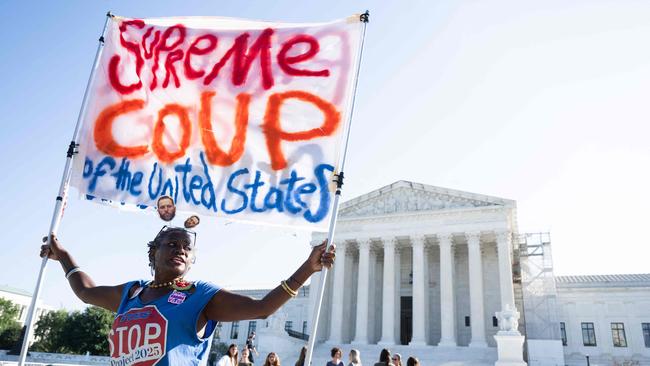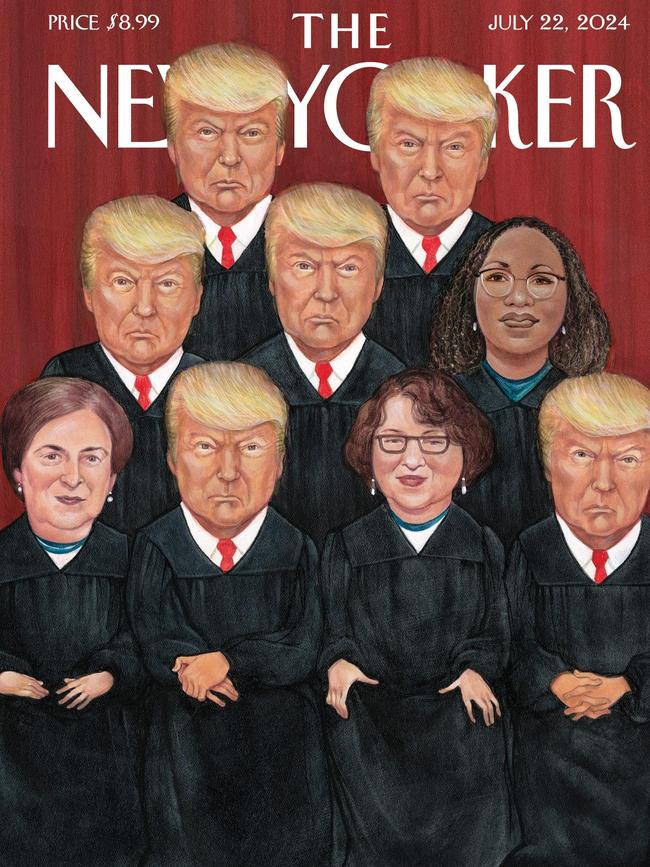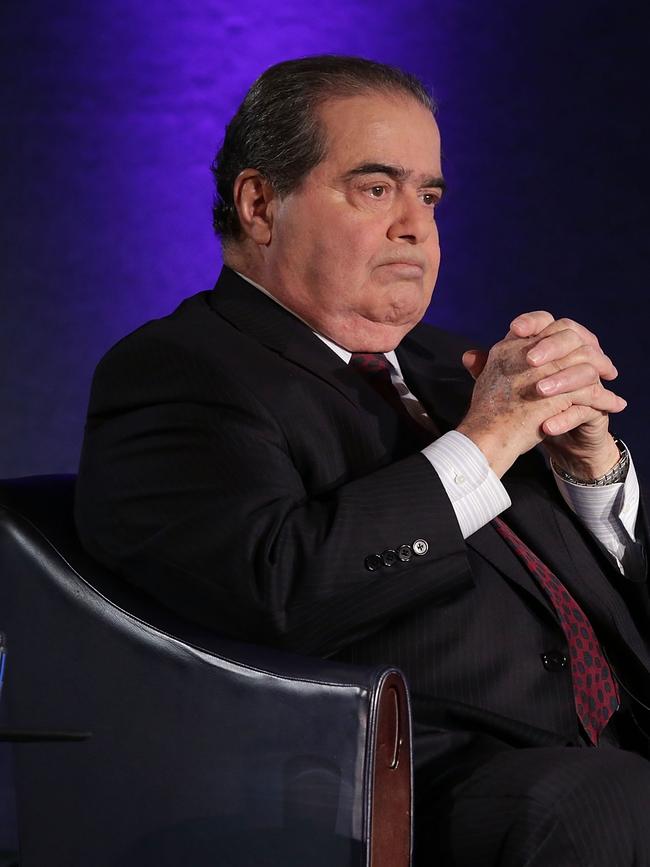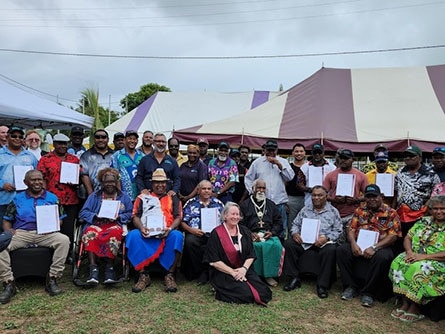The legal profession’s giant lurch to the left
The collective Yes position on the voice was the tip of the legal profession’s politically ‘progressive’ iceberg.

Get it?
The cover drawing by Anita Kunz wasn’t clever. Even casual followers of US politics, let alone sophisticated readers of The New Yorker, know that all SCOTUS picks are hyper-political. President Joe Biden picked Jackson. Barack Obama picked Kagan and Sotomayor. Republican presidents, including Trump, picked the rest.

When Democrats slot their favourites into courts, it’s nothing more than the natural order of things. But few things drive the left crazier than when Republican administrations stack the courts. When Trump did it, the left’s Trump derangement syndrome soared.
The New Yorker cover would have been sharper had the six Supreme Court justices been pictured wearing a blue Federalist Society necktie.
This organisation deserves its dues.
Supreme Court Chief Justice John Roberts, and fellow justices Samuel Alito, Brett Kavanaugh, Clarence Thomas, Neil Gorsuch and Amy Coney Barrett all have Federalist Society ties – as in, all have an association with the Federalist Society.
Before bringing you news about green shoots of a similar society in Australia, and why it’s needed here, it’s worth understanding how the Federalist Society got started, and its influence today – even beyond the legal icing of filling seats on America’s highest court.
In April 1982, just after Ronald Reagan was elected US President, four law students from elite law schools at Harvard, Yale and University of Chicago launched a legal counterculture revolt. They were responding to the post-war judicial activism of the Warren and Burger Supreme Courts. The best-known trademark of this judicial activism was surely Roe v Wade.
No Che Guevaras, these legal revolutionaries organised a three-day symposium with the dreary title: A Symposium of Federalism – Legal and Political Ramifications.
Still, they tapped into something. The conference attracted people who would become conservative legal rock stars, including Antonin Scalia and Robert Bork. Famously, Bork didn’t make it through the US Senate confirmation process. Scalia sailed through with 98-0 votes and dominated the Supreme Court until his death in 2016.

Contrary to Reagan’s famous quip that the nine most terrifying words in the English language are I’m from the government, and I’m here to help, Scalia told the gathering: “I urge you – as Hamilton would have urged you – to keep in mind that the federal government is not bad but good. The trick is to use it wisely.”
Unknown to the founders, here was the dawn of the Federalist Society. More than four decades later, myriad books detail the group’s influence. The scorecard is impressive.
There is a student-led Federalist Society chapter at around 200 American law schools spreading the gospel of conservative legal principles; a majority of Supreme Court justices checking federal power; federal appeals courts filled with Federalist Society members too, including 25 of Trump’s 30 appointments when he was president; along with 90 lawyers’ chapters for those in the professions.
Sour over this legacy, the left complains about dark forces changing the nation. Translate “dark forces” into the Supreme Court returning to the original intention of the framers, rather than the “liberal” – in the American sense – impulse to play philosopher king with the Constitution.
Unhappy with slow pace of abortion rights, in Roe v Wade the USSC famously conjured up an abortion right. The majority usurped the state legislatures, created that right and ripped the country apart.
In 2022, the new conservative majority on the court overturned Roe v Wade, returning the issue to the people where it’s being rapidly and democratically settled on a state-by-state basis. This is federalism writ large – delivered by the Federalist Society’s legal conservatives (loosely, we call it black letter law, Americans call it originalism).
While Federalists openly speak about the “judges project” – compiling lists of esteemed legal conservatives for the judiciary – its long-term success comes from getting into law schools four decades ago. Today, it devotes serious resources to educating students about the US Constitution.
The society isn’t preaching or playing politics. It’s an ideas factory, for young and old, hosting high-calibre networking events where you can hear from people with different views but tethered to the unifying idea that a nation’s legislature must make the laws within the confines of the Constitution and, likewise, judges should stick to the founding document by following originalist principles.
As Scalia told me years ago, a constitution should be clear, stable – and boring. It is, after all, federalism’s instruction manual.
The society’s glitziest event is its annual convention in Washington DC. This year, it kicks off on November 14 with the sold-out black-tie Antonin Scalia Memorial Dinner and ends with the Robert H Bork memorial lecture three days later.
Among more than 2000 people who will attend this year’s legal extravaganza next month will be a young Australian lawyer.
Quietly spoken, Xavier Boffa is on a mission to create the same influential legal force in Australia. The young man from Melbourne has spent the past three years speaking with people at “Fed Soc” – the abbreviation is his, and comes from saying it so often.
At 28, he’s both the youngest and the first full-time executive director of the Samuel Griffith Society. And he’s turning the SGS upside down.
Established in 1992, over three decades well-established lawyers, academics and judges from our highest courts have delivered papers and joined the audience at the annual SGS conference. These members created and nurtured the intellectual backbone of the SGS.
With due respect to its founders and early supporters, among them Sir Harry Gibbs, John Stone and Hugh Morgan, Boffa says everything is focused on educating students, inviting them to events, offering scholarships to attend their annual conference, running essay competitions, identifying talent.
Boffa understands that longstanding change comes from making the case to students that legal humility and respect for the rule of law maintains a healthy democracy, rather than turning the Constitution into a manual for social engineering that you might find in the People and Culture section of a woke corporation.
Being a legal conservative should be cool. It’s about freeing people from the yoke of centralised unchecked authority, be it a federal government or judges ignoring the Constitution.
Creating an Australian version of the Federalist Society can’t come soon enough. To be sure, we haven’t had our Roe v Wade. It’s more a case of the potential death of the rule of law by a thousand cuts. Though some cuts are more like gaping wounds.
Who can forget Federal Court judge Mordy Bromberg creating a brand spanking new duty of care in 2021 requiring the federal environment minister to not make decisions that could harm future generations. Sense prevailed when his climate change dream was rejected on appeal.
But even our most senior judges drift into the role of philosopher king and queen.
A topic of much conversation among SGS members has been Love v The Commonwealth. In 2020, the High Court created a brand new constitutional right not to be treated as an alien in favour of Indigenous people who were not born here, and who were citizens of another country. All they had to do was claim some “spiritual or metaphysical” connection with Australia.
Vatican smoke signals are clearer than the waft emanating from this decision.
Eminent Melbourne silk Allan Myers is president of the SGS society. At the annual conference last year, the Kings Counsel didn’t mince words, telling the audience that High Court judges should not be “innovators remaking society”.

“Their duty is to administer the law and thereby to keep the foundations of society steady. If they are unhappy with the constraints of judicial office, they should, like Doc Evatt did, resign from office and seek election to parliament,” Myers told the crowd.
The giant lurch to the left within the legal profession is happening just about every week. On Tuesday, the Victorian Supreme Court hosted a ceremonial sitting for Indigenous people. It was a livestreamed show of politics, not law, with speakers advocating for special rights, separate laws and declaring that Indigenous sovereignty has not been ceded – even in the face of a clear High Court decision to the contrary.
These sorts of claims might be celebrated at a political rally, raised at a conference, or heard from a screeching Lidia Thorpe. It’s concerning when the Victorian Supreme Court sends a message that the Victorian justice system has taken sides in political race debates.
The NSW Judicial Commission “therapeutic justice” manual directs judges to adopt racial stereotypes by considering “pervasive intergenerational effects of settler-colonialism” when sentencing Indigenous defendants. The commission also recommends judges apply cultural stereotypes to other groups, for example to Muslims who may have “a sense of personal responsibility to react to world events, in the context of religious injunctions to support others of the same faith”.
In other words, our judges are telling Lady Justice to rip off her blindfold, to buck the rule of law and align with political agendas of colonisation and so on.
Highlighting the parlous state of the legal system, judges have been silent about these political interventions. And, of course, not a word of caution from bar associations or law societies either.
It’s hard for individual barristers to go public given it’s their job to appear for clients in front of such judges. However, one senior silk told Inquirer these political directives from the NSW Judicial Commission are untenable. “We need to be careful about going down this path,” the senior barrister said this week, “because it may well lead to disrespect for the court flowing onto the streets.”
How many judges remain truly committed to maintaining public confidence in the legal and justice system? The August edition of the NSW Bar Association’s Bar News featured a photograph of Federal Court Chief Justice Debbie Mortimer smiling with a group of winning plaintiffs in a piece of native title litigation, after her Honour’s judgment in David on behalf of the Torres Strait Regional Seas Claim v State of Queensland.

Another senior silk told Inquirer that it’s not important whether the judge’s cause is admirable. They often are. What’s important is whether revealing these causes damages the integrity of the courts and the legal system.
The barrister explained that as a judge, you cannot pick and choose the causes you wish to celebrate, without endorsing the freedom of every other judge to celebrate their preferred cause. “Of course, one photo in a case like this is not the end of the world. However, I believe it is emblematic of a developing trend. We are witnessing a pronounced and increasing deviation from longstanding conventions in relation to judicial independence and impartiality. It is increasingly common for judges to speak out on large and controversial social issues – Indigenous legal issues being just one,” the silk told Inquirer.
No one should take for granted that Australia has enjoyed a stable and competent legal system, says the barrister. One essential ingredient is that historically, judges have adhered to the convention that once they accept judicial appointment, they keep out of political controversies other than when required to decide them in court.
“Imagine a judge posing in a photo with other types of successful litigants, such as corporations or government ministers. We would all rightly condemn this.”
When a judge is known to sympathise with a particular cause, lawyers will do the same to gain favour with the judge.
The collective Yes position on the voice was the tip of the legal profession’s politically “progressive” iceberg.
The green shoots of an Australian Federalist Society unfolded on Friday afternoon in an unexceptional campus office at the University of NSW. Helped by Boffa and the SGS, young law student Thomas O’Keefe and a handful of other students set up the university’s first student-led SGS chapter.
O’Keefe, a third year Arts/Law student, says he’s seeing an appetite from students to learn more about the Constitution. While there are scraps of civics education at school, there is no constitutional education. At university, law students will get some, but mostly late in their degree.
Another handful of students started the very first SGS chapter at ANU in Canberra last semester. Already, they have held events and attracted 80 members, with plans for a podcast series about the High Court.
Pilot SGS chapters are also under way, to different degrees, at University of Queensland, Deakin University and the Australian Catholic University, with plans for more chapters at other universities.
Why isn’t there one at Melbourne University yet? Boffa says it’s a tough place to encourage humility towards the Constitution. But he knows that the more hostile the environment, the more a SGS chapter is needed to offer students an alternative.
Boffa has the support of Myers and the entire SGS board to upturn the society, to focus on students and, with the ambition of re-tethering lawyers and judges to the rule of law.
“We’re thinking 10 years from now. There’s one vacancy on the High Court in the next decade and then, after 2034, in the space of about two years, there are four more vacancies if all judges serve until retirement age.”
There’s no point thinking about who to put on the High Court a year out from a vacancy, as the Abbott, Turnbull and Morrison government did. Boffa says identifying legal talent needs to start now.
Success will come down to resources. Change requires money. Perhaps there is a quiet billionaire willing to back the rule of law, just as a couple of wealthy Americans did for the Federalist Society 40 years ago.






Back in July, a cover of The New Yorker featured a caricature of United States Supreme Court justices, donning judicial robes. Those in the front row are seated with hands folded, the rest standing behind. Six of them have Donald Trump’s scowling face superimposed on them, and a Republican red necktie peeking out from their robe. The other three judges, Sonia Sotomayor, Elena Kagan and Ketanji Brown Jackson, bear their own faces.